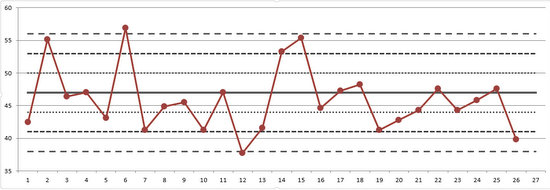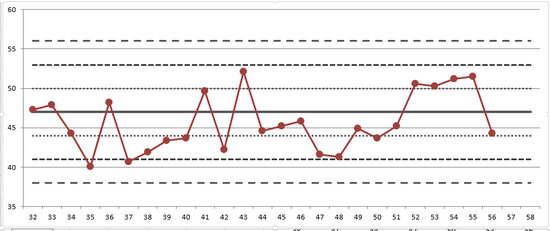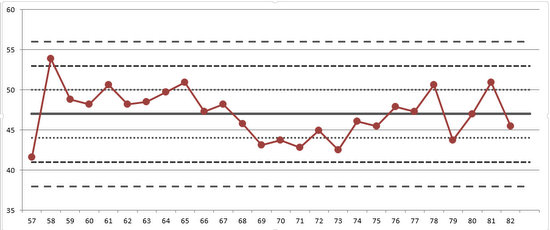Basic QC Practices
Break all the Rules! (Part One)
We spend most of our time trying to keep all of our data within the limits, obeying the rules, maintaining compliance. But if we needed to, could we recognize when the rules were really broken? Here's a simple exercise - if you're told that all the rules have been broken, can you find where the violations occurred?
Break All the Rules! (Part One)
Sten Westgard, MS
July 2015
As a laboratorian, we are constantly aiming for compliance, for an absence of problems, for a stream of data points that land lovingly near the mean. As a contrarian exercise, this article is going to be about the exact opposite of getting all your data to stay in control. We're going to look at data that's out-of-control, breaking all of the various "Westgard Rules." And we're going to see if you can identify which data points are outliers and which rules are being broken.
As the title suggests, this is just the first installment. We're going to start simple and then gradually increase the level difficulty. Eventually, we'll throw the really clever errors your way and see if you can still catch them.
The data
The following data set is going to have a mean of 47 and an SD of 3. I'm not going to tell you which test or what units are involved. They're irrelevant to this exercise. We're also not going to look at the total allowable error or CV or bias. All of that becomes important after we know the basics of QC and charting.
Control Measurement |
Value |
Z-value |
Rule Broken |
| 1 | 42.5 | ||
| 2 | 55.1 | ||
| 3 | 46.4 | ||
| 4 | 47.0 | ||
| 5 | 43.1 | ||
| 6 | 56.9 | ||
| 7 | 41.3 | ||
| 8 | 44.9 | ||
| 9 | 45.5 | ||
| 10 | 41.3 | ||
| 11 | 47.0 | ||
| 12 | 37.7 | ||
| 13 | 41.6 | ||
| 14 | 53.3 | ||
| 15 | 55.4 | ||
| 16 | 44.6 | ||
| 17 | 47.3 | ||
| 18 | 48.2 | ||
| 19 | 41.3 | ||
| 20 | 42.8 | ||
| 21 | 44.3 | ||
| 22 | 47.6 | ||
| 23 | 44.3 | ||
| 24 | 45.8 | ||
| 25 | 47.6 | ||
| 26 | 39.8 | ||
| 27 | 39.8 | ||
| 28 | 50.9 | ||
| 29 | 49.7 | ||
| 30 | 45.5 | ||
| 31 | 45.2 | ||
| 32 | 47.3 | ||
| 33 | 47.9 | ||
| 34 | 44.3 | ||
| 35 | 40.1 | ||
| 36 | 48.2 | ||
| 37 | 40.7 | ||
| 38 | 41.9 | ||
| 39 | 43.4 | ||
| 40 | 43.7 | ||
| 41 | 49.7 | ||
| 42 | 42.2 | ||
| 43 | 52.1 | ||
| 44 | 44.6 | ||
| 45 | 45.2 | ||
| 46 | 45.8 | ||
| 47 | 41.6 | ||
| 48 | 41.3 | ||
| 49 | 44.9 | ||
| 50 | 43.7 | ||
| 51 | 45.2 | ||
| 52 | 50.6 | ||
| 53 | 50.3 | ||
| 54 | 51.2 | ||
| 55 | 51.5 | ||
| 56 | 44.3 | ||
| 57 | 41.6 | ||
| 58 | 53.9 | ||
| 59 | 48.8 | ||
| 60 | 48.2 | ||
| 61 | 50.6 | ||
| 62 | 48.2 | ||
| 63 | 48.5 | ||
| 64 | 49.7 | ||
| 65 | 50.9 | ||
| 66 | 47.3 | ||
| 67 | 48.2 | ||
| 68 | 45.8 | ||
| 69 | 43.1 | ||
| 70 | 43.7 | ||
| 71 | 42.8 | ||
| 72 | 44.9 | ||
| 73 | 42.5 | ||
| 74 | 46.1 | ||
| 75 | 45.5 | ||
| 76 | 47.9 | ||
| 77 | 47.3 | ||
| 78 | 50.6 | ||
| 79 | 43.7 | ||
| 80 | 47.0 | ||
| 81 | 50.9 | ||
| 82 | 45.5 |
Now, in addition to this data, I'm going to add the following conditions:
- We are only running ONE control per run; assume each value represents one run (this is not realistic from a US CLIA scenario, but we've got to start small)
- We're NOT going to be able to implement the R:4s control rule, since we don't have two values that occur within a single run (and that's the recommended interpretation of this rule)
- We're NOT going to look for 2s violations. Let's break that habit right now. In any case, I didn't generate these data points randomly, so we're not going to expect to see a certain number of 2s outliers
- We ARE going to try to find outliers of the following "Westgard Rules": 1:3s/2:2s/R:4s/4:1s/8:x (except remember the R:4s is not applicable)
- We're NOT going to get into the swamp that is repeating of controls. So don't assume anything you see is a repeated control - just stick with "in" or "out"
The Charts
I suspect this is a very long table for most readers. And probably I'm asking quite a bit for readers to convert this chart into something like a levey-jennings chart. So we'll help out immediately by generating some Levey-Jennings control charts
Here are the first 27 data points:

Here are the second set of data points (from 32 through 56):

Here's the last set of data points (57 through 82):

(Obviously, any data points not shown on these charts are automatically not important to our exercise.)
So, at the end of this, can you answer the following questions?
- How many rule violations were there?
- Which rules were violated and how many times?
- What would be different if I told you that only the "Westgard Rules" 1:3s/2:2s/R:4s were necessary? (and remember, R:4s can't be applied)
- What would be different if I told you that only the 1:3s control rule was necessary?
These answers, and more, next month...
[Don't feel like you have to submit this exercise for grading. But perhaps you can share this with your colleagues and see if you can reach the same conclusions and interpretations.]
